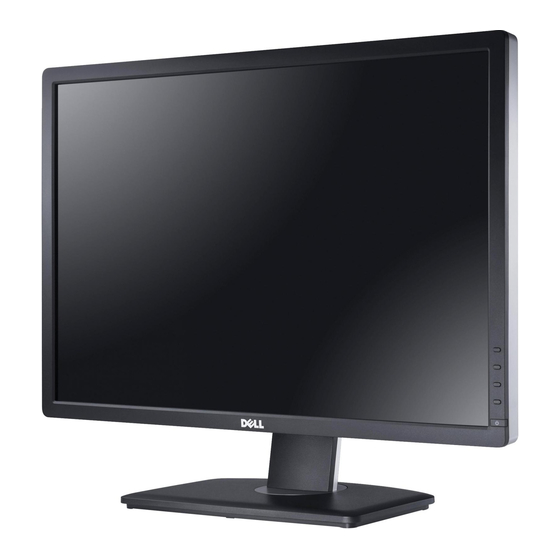- ページ 44
モニター Dell UltraSharp U2412MのPDF ユーザーマニュアルをオンラインで閲覧またはダウンロードできます。Dell UltraSharp U2412M 49 ページ。 Dell u2412m monitor user's guide
Dell UltraSharp U2412M にも: 仕様 (3 ページ), セッティングマニュアル (2 ページ), 製品寸法 (1 ページ), ユーザーマニュアル (43 ページ), ユーザーマニュアル (37 ページ), ユーザーマニュアル (48 ページ)

Synchronization Problems
Screen is scrambled or appears torn
Safety Related Issues
Visible signs of smoke or sparks
Intermittent Problems
Monitor malfunctions on & off
Missing Color
Picture missing color
Wrong Color
Picture color not good
Image retention from a static image left on the
Faint shadow from the static image displayed appears on
monitor for a long period of time
the screen
Product Specific Problems
Specific Symptoms
Screen image is too small
Image is centered on screen, but does not fill entire
viewing area
Cannot adjust the monitor with the buttons on the front
OSD does not appear on the screen
panel
No input signal when user controls are pressed
No picture, the LED light is blue
The picture does not fill the entire screen.
The picture cannot fill the height or width of the screen
NOTE:
When choosing DVI-D mode, the Auto Adjust function will not be available.
Universal Serial Bus (USB) Specific Problems
Specific Symptoms
USB interface is not working
USB peripherals are not working
High Speed USB 2.0 interface is slow.
High Speed USB 2.0 peripherals working slowly or not
working at all
Dell™ Soundbar Problems
Common Symptoms
No Sound
No power to Soundbar - the power indicator is off
No Sound
Soundbar has power - power indicator is on
Distorted Sound
Computer's sound card is used as the audio source
Adjust Phase and Pixel Clock controls via OSD.
Perform monitor self-test feature check and determine if these lines are also in self-test mode.
Check for bent or broken pins in the video cable connector.
Run the built-in diagnostics.
NOTE:
When using DVI-D input, the Pixel Clock and Phase adjustments are not available.
Reset the monitor to Factory Settings.
Perform Auto Adjust via OSD.
Adjust Phase and Pixel Clock controls via OSD.
Perform monitor self-test feature check to determine if the scrambled screen appears in self-test mode.
Check for bent or broken pins in the video cable connector.
Restart the computer in the safe mode.
Do not perform any troubleshooting steps.
Contact Dell immediately.
Ensure that the video cable connecting the monitor to the computer is connected properly and is secure.
Reset the monitor to Factory Settings.
Perform monitor self-test feature check to determine if the intermittent problem occurs in self-test mode.
Perform monitor self-test feature check.
Ensure that the video cable connecting the monitor to the computer is connected properly and is secure.
Check for bent or broken pins in the video cable connector.
Change the Color Setting Mode in the Color Settings OSD to Graphics or Video depending on the application.
Try different Color Preset Settings in Color Settings OSD. Adjust R/G/B value in Color Settings OSD if the Color Management is turned off.
Change the Input Color Format to PC RGB or YPbPr in the Advance Setting OSD.
Run the built-in diagnostics.
Use the Power Management feature to turn off the monitor at all times when not in use (for more information, see
Alternatively, use a dynamically changing screensaver.
What You Experience
Check the Scaling Ratio setting in Image Setting OSD
Reset the monitor to Factory Settings.
Turn off the monitor, unplug the power cord, plug it back, and then turn on the monitor.
Check whether the OSD menu is locked. If yes, press and hold the button above the Power button for 10 seconds to unlock (for more information, see
Check the signal source. Ensure the computer is not in the power saving mode by moving the mouse or pressing any key on the keyboard.
Check whether the signal cable is plugged in properly. Re-plug the signal cable if necessary.
Reset the computer or video player.
Due to different video formats (aspect ratio) of DVDs, the monitor may display in full screen.
Run the built-in diagnostics.
What You Experience
Check that your monitor is turned ON.
Reconnect the upstream cable to your computer.
Reconnect the USB peripherals (downstream connector).
Switch off and then turn on the monitor again.
Reboot the computer.
Some USB devices like external portable HDD require higher electric current; connect the device directly to the computer system.
Check that your computer is USB 2.0-capable.
Some computers have both USB 2.0 and USB 1.1 ports. Ensure that the correct USB port is used.
Reconnect the upstream cable to your computer.
Reconnect the USB peripherals (downstream connector).
Reboot the computer.
What You Experience
Turn the Power/Volume knob on the Soundbar clockwise to the middle position; check if the power indicator (Blue LED) on the front of the Soundbar is illuminated.
Confirm that the power cable from the Soundbar is plugged into the adapter.
Plug the audio line-in cable into the computer's audio out jack.
Set all Windows volume controls to their maximum.
Play some audio content on the computer (i.e. audio CD, or MP3).
Turn the Power/Volume knob on the Soundbar clockwise to a higher volume setting.
Clean and reseat the audio line-in plug.
Test the Soundbar using another audio source (i.e. portable CD player).
Clear any obstructions between the Soundbar and the user.
Power Management
Possible Solutions
Possible Solutions
Possible Solutions
Modes).
Menu
Lock).
